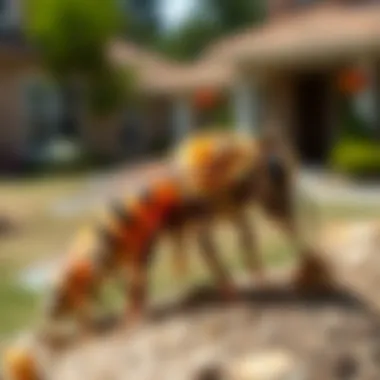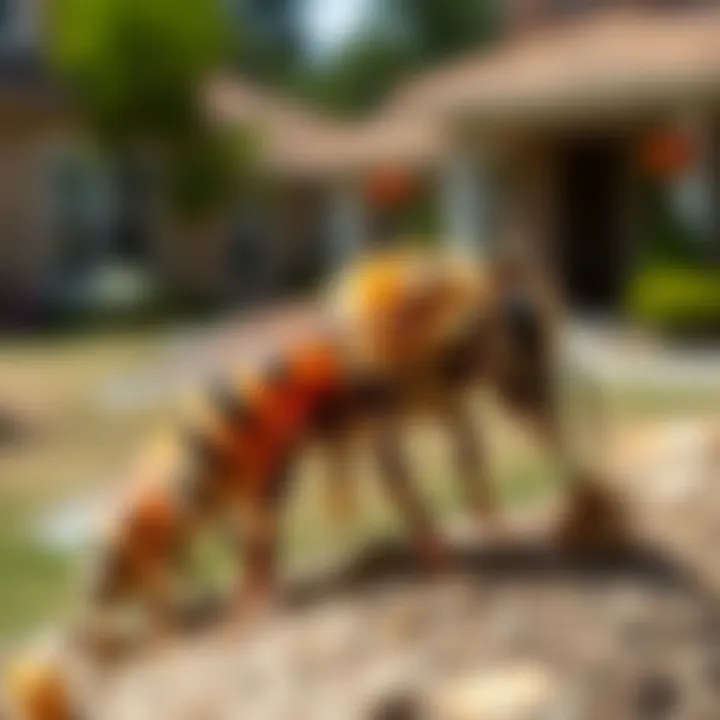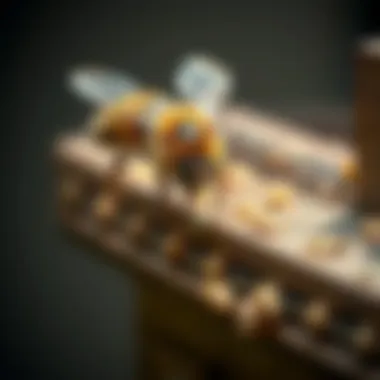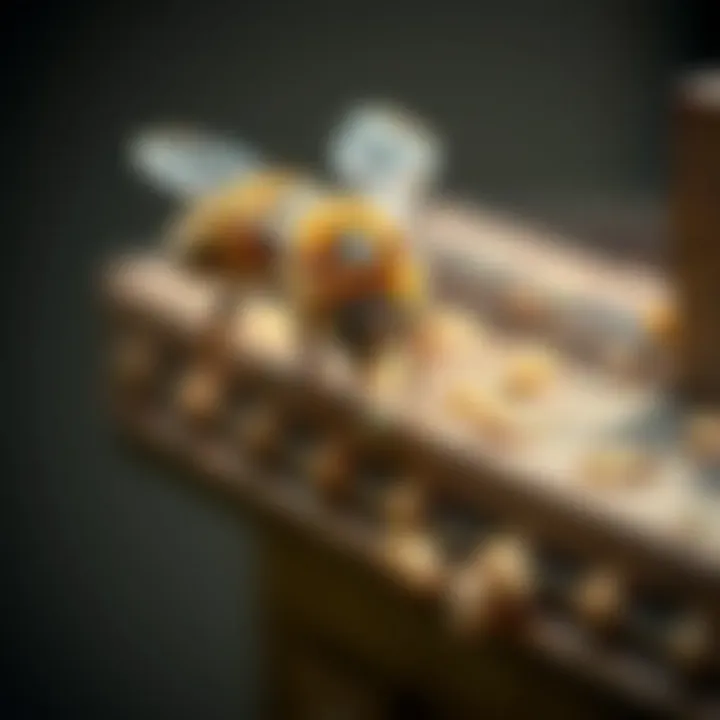Smart Ways to Keep Bees Away from Your Home


Intro
Bees play a crucial role in our ecosystems, but their presence in and around our homes can cause discomfort and concern. Their ability to invade residential spaces often leads to worry about safety, especially for those with allergies. Understanding how to manage and prevent bees from entering your home is essential for creating a comfortable living environment.
Understanding the Pest
Identification
Recognizing different types of bees is the first step in prevention. While honeybees are most commonly known for their production of honey, other species like bumblebees and carpenter bees also have strong tendencies to invade homes.
- Honeybees are fuzzy and yellow with black stripes. They are generally sociable and thrive in colonies.
- Bumblebees are larger and rounder, often seen buzzing around colorful flowers.
- Carpenter bees resemble bumblebees in appearance but have shiny, hairless abdomens. They can be problematic as they burrow into wood, making them a nuisance for homeowners.
Life Cycle
Understanding the life cycle of bees helps in developing effective strategies for deterrence. Bees typically go through four stages: egg, larva, pupa, and adult. The queen bee is responsible for laying eggs, which hatch into larvae. As they develop, larvae are fed by worker bees until they mature into adults.
This cycle usually peaks in the warmer months, leading to higher chances of encounters as bees forage for food. Knowing this can guide homeowners on when to be particularly vigilant.
Pest Prevention Strategies
Environment Modification
Modifying your environment can significantly decrease the chances of bees setting up shop at your place. Here are some effective strategies:
- Remove Food Sources: Keep your outdoor space clean. Bees are attracted to sugary substances, including discarded food and drinks. Make sure to cover trash cans and clean up spills promptly.
- Opt for Bee-Resistant Plants: If landscaping, consider planting flowers less appealing to bees. Certain varieties like marigolds or lavender might attract them less than others, such as sunflowers or honeysuckle.
- Maintain Your Property: Regular upkeep of your yard and home reduces potential nesting sites. Seal any cracks in foundation or walls where bees might find an entry point.
Physical Barriers
Setting up physical barriers can be an effective way to keep bees at bay. Possible solutions include:
- Screens on Windows and Doors: Installing fine mesh screens can prevent bees from entering your home through openings.
- Bee Traps: Using bee traps strategically around your yard can help reduce the local population. These traps can be homemade or purchased, designed to lure and trap bees without harming them.
- Bee-Repellent Cloth: Hanging cloths soaked in diluted peppermint or cucumber oil around certain areas can deter bees, as they are inclined to stay away from such scents.
Control Methods
Chemical Control
While natural methods are preferred, sometimes chemical solutions may be necessary to control a severe infestation. It's vital to choose products that are labeled for outdoor use and are as environmentally friendly as possible. Always follow the manufacturer's instructions for safe application.
Biological Control
Biological control involves introducing natural predators to help manage bee populations. This method encourages a healthy ecosystem and often leads to sustainable practices without harming bees or other beneficial insects.
"Bees are our friends, and while protecting our homes is important, finding a balance is key."
In summary, preventing bees from invading your home requires a combination of understanding their behavior, modifying your environment, and employing effective physical barriers and control methods. With thoughtful consideration and action, homeowners can keep their spaces comfortable while respecting these vital creatures in our ecosystem.
For further reading on bees and their behaviors, check resources from Wikipedia and Britannica as well as insights on community platforms like Reddit or Facebook.
By arming yourself with knowledge and proactive strategies, you'll be well-equipped to deter bees while maintaining a delicate balance with nature.
Understanding Bee Behavior
Understanding bee behavior is crucial for effectively preventing these industrious insects from intruding in our homes. Bees play an important role in pollination and contribute to the ecosystem, but their cohabitation with humans should be managed. Recognizing how and why bees behave a certain way will help homeowners take preventive measures that don't disrupt the delicate balance between human habitation and nature.
Types of Bees Likely to Enter Homes
When it comes to domestic encounters with bees, different species may pop up. The most common culprits are honeybees, bumblebees, and carpenter bees. Honeybees are attracted to flowering plants and often build their hives in sheltered areas such as attics, chimneys, or wall cavities. Bumblebees, on the other hand, are known for their social behavior and can be found nesting in the ground, making it more likely for them to wander into yards.
Carpenter bees, which resemble bumblebees but are more solitary, are notorious for drilling into wood, making them a significant concern for wooden structures. These little guys love untreated wood, and homeowners might find them making nests in fence posts or overhangs. It's essential to identify these bees correctly since each type has its own nesting habits and behaviors that might either invite or deter their presence in residential areas.
Seasonal Patterns of Bee Activity
Bees follow a seasonal pattern influenced by temperature and blooming flowers. Spring marks the start of their active period, as they wake up from dormancy and search for food sources. During spring, you might find them buzzing around your garden as they gather pollen. This is also the time when they establish new colonies—highlighting the importance of being vigilant before they start looking for nesting sites.
As summer rolls around, bee activity peaks, with foraging becoming more aggressive since they're collecting resources for their hives. With the arrival of autumn, the dynamics shift. Many colonies begin to dwindle, and bees become less aggressive. However, this is also a time when they may invade homes as they seek shelter for the colder months. Understanding these patterns allows homeowners to fortify their spaces proactively: the best defense is a good offense.
Nesting Habits of Common House Bees
Nesting habits play a significant role in determining how bees invade homes. Honeybees normally build their hives in protected spaces, like attics or wall cavities. Bumblebees often take advantage of abandoned rodent burrows, while carpenter bees enjoy creating cavities in soft wood.
To dissuade these little pests from making themselves at home, homeowners should focus on monitoring and maintaining potential nesting sites. Regularly inspecting areas that provide shelter, like eaves, attics, and wooden structures, can significantly reduce the risk of bee invasions. This proactive approach not only protects your home but also helps in minimizing interactions that could lead to stings, ensuring a peaceful living environment.
"Prevention is better than cure." Keeping an eye on the nesting habits of local bee species fortifies your home while also helping the environment thrive.
Identifying Potential Entry Points
Identifying potential entry points is critical when it comes to preventing bees from entering your home. Bees are instinctively drawn to sheltered places that offer warmth and safety for nesting. By pinpointing these entryways, homeowners can proactively guard against unwanted intrusions. This section will examine the common routes bees may take and provide insights on how to secure these areas effectively, thus maintaining a comfortable and safe living environment.


Common Entry Points in Residences
Many homeowners may not realize that there are various common entry points where bees can sneak into residential properties. These can include:
- Gaps in siding: Small cracks or openings in the external siding often serve as convenient access points for bees looking to settle down.
- Eaves and overhangs: Openings under eaves can often be overlooked, making them prime spots for bee invasion.
- Attic vents: Vents that aren’t screened properly provide an easy path for bees to buzz into the darker, cooler spaces of your home.
- Chimneys: Bees can also find their way into fireplaces or chimneys if they’re not adequately capped or screened.
Being aware of these entry points is the first step in creating a bee-proof home. Addressing these areas not only keeps bees out but can also help improve overall energy efficiency.
Inspecting Doors and Windows
Ensuring that doors and windows are tightly sealed is another essential measure. Inspecting these areas can help reveal hidden vulnerabilities. Pay attention to gaps that can often be seen around:
- Frames: Look for any wear and tear, peeling paint or warped frames that may leave slits open for bees.
- Weather stripping: Old or worn weather stripping might be ineffective, letting bees slip right in. Replace any damaged strips to ensure a tight seal.
Additionally, installing mesh screens on windows can significantly reduce bee access while allowing fresh air into your home. Opt for finer mesh to deter smaller bees effectively.
Evaluating Wall and Roof Structures
Another major consideration for bee prevention involves evaluating your home’s wall and roof structures. These can often hide entry points that might not be visible at first glance. Make sure to check:
- Roof junctions: Cracks where the roof meets the walls can serve as convenient bee entry points. Maintaining these areas with proper sealing can prevent any potential nesting.
- Gutters: Clogged gutters can hold moisture and attract bees for access. Keeping them clear and ensuring they are properly installed can mitigate the risk.
- Soffits: Like eaves, checking soffits carefully for gaps or holes is crucial, as bees often find them comfortable for sheltering.
By systematically evaluating these structures, homeowers can take decisive action in sealing off potential entry points, effectively reducing the chances of bee intrusion.
Regularly inspecting and maintaining your home’s external structures not only keeps bees away but also extends the life of your property.
By addressing these potential points of entry, homeowners gain an edge in keeping their environment more controllable and pleasant.
Preventive Maintenance Techniques
Preventive maintenance techniques are indispensable for keeping bees at bay and ensuring a comfortable home environment. Addressing potential issues before they become problems can save homeowners considerable time, effort, and money in the long run. The key to an effective strategy involves not just looking at the exterior but also understanding how simple household upkeep can deter bees from venturing too close to your residence.
Consider how bees view your home. They’re not just buzzing insects; they’re searching for nesting sites, places where they can thrive and multiply. By maintaining your home diligently, it’s possible to reduce the appeal of your space, lowering the chances of an unwelcome visit from these determined pollinators.
Sealing Cracks and Gaps
Identifying and sealing the cracks and gaps around your home is one vital step in preventive maintenance. Bees find their way inside through tiny openings, often overlooked by homeowners. Starting inside, check areas around pipes, electrical lines, and plumbing fixtures for any gaps. These areas can be patched up with caulking or expanding foam. Outside, inspect the perimeter of doors and windows. If you find old weather stripping worn down or gaps where the sun shines through, it’s a smart move to replace or seal them.
"A stitch in time saves nine."
Proactive maintenance can significantly reduce unforeseen problems.
When sealing, consider the materials used: some bees may be drawn to certain odors, so it’s essential to choose neutral options. Additionally, regular maintenance checks can help catch these issues early, before they become something that attracts bees.
Installing Screens on Windows and Vents
Next, the installation of screens on windows and vents can significantly enhance your defense against bee invasions. Well-fitted screens act as a barrier, keeping pesky insects from sneaking inside while allowing fresh air to circulate. It’s important to choose high-quality materials resistant to wear and tear, especially if you live in regions with an abundance of bee activity.
Another key element is ensuring there are no tears or holes in the screens. Over time, weather and usage can damage them, providing an entry point for bees. Investing in stainless-steel mesh screens, which are more durable, can thwart their attempts to infiltrate your space. A regular inspection of these screens during seasonal transitions can help catch wear before it’s too late.
Regular Home Inspections
Finally, adopting a routine of regular home inspections is one of the best proactive steps a homeowner can take. Aiming to conduct these checks at least twice a year allows you to stay ahead of potential bee problems. It’s not just about looking for cracks and gaps; it’s about assessing the overall state of the exterior, roof, and eaves.
During your inspection, look for signs that might indicate bee presence, like unusual buzzing sounds or leftover pollen and debris around the home. Taking notes of what you observe ensures you don’t miss anything important.
Consider forming a checklist to keep the inspection process organized. This could include:
- Inspecting seals around windows and doors.
- Checking vents and exhausts for adequate screening.
- Looking at the exterior for cracks or signs of wear.
- Observing shrubs and landscaping for areas that might attract bees.
By adhering to preventive maintenance techniques, homeowners not only keep bees out but also enhance their home's durability and aesthetic. These simple yet effective strategies set the groundwork for a harmonious living environment.
Landscaping and Outdoor Modifications
Landscaping and outdoor modifications play a significant role in keeping bees at bay. When homeowners are mindful about what they plant and how they maintain their yard, it can lead to a harmonious environment that reduces the likelihood of bee invasion. This goes beyond mere aesthetics; it’s about creating a living space that is both beautiful and conducive to your comfort and safety.
Choosing Bee-Hostile Plants
While a colorful garden is often the pride of any homeowner, it's wise to select plants that are less appealing to bees. For instance, you might lean towards shrubs like boxwood or certain ornamental grasses that don’t attract these pollinators. Here’s a simple list of bee-hostile plants you might consider:
- Lavender
- Marigold
- Daffodils
- Pansies
- Many herbaceous perennials like ferns
These plants provide beauty without beckoning bees. Also, think about avoiding vibrant blooms known to attract them, like sunflowers or daisies. Understanding which plants to keep and which to avoid is a crucial step in designing your outdoor space.
Maintaining A Clean Yard
A clean yard is not just visually appealing; it's a proactive step in deterring bees. Regularly clear away debris such as fallen leaves, which can create nesting places. Additionally, dispose of any overripe fruits or food waste; these can lure bees into your vicinity. Maintaining cleanliness helps tremendously in keeping bees at bay, as they are attracted to anything that hints at a food source.
- Pick up fallen fruits: This is particularly important in summer and early fall.
- Clear out old garden waste: Tidying the edges of flower beds is key.
- Trim overgrown plants: This minimizes the chances of creating habitat.
Above all, foster an environment of diligence around your outdoor space. This not only denies bees nesting opportunities but also fosters a healthier overall yard.


Strategic Plant Placement
Strategic plant placement can further minimize the risk of bee intrusion. By situating plants that attract bees far away from high-traffic areas—such as entrances or patios—you lessen the likelihood of encounters. Think of it like a buffer zone, protecting your home from uninvited buzzers.
- Create designated flowering areas: Place blooming plants in a distinct part of the yard, away from windows and doors.
- Use borders effectively: Low-lying shrubs can act as barriers against bees who prefer to roam without hindrance.
- Plant diversity: Using a variety of foliage, not just blooms, can confuse bees that may venture too close.
Placing plants strategically not only deters bees but also contributes to a more organized and visually pleasing landscape.
It's vital to understand that your yard can either become a sanctuary for bees or a barrier against them. Approach landscaping choices with intention, and you'll pave the way for a bee-free environment.
Utilizing Natural Deterrents
In the quest to keep your home bee-free, embracing natural deterrents can work wonders. Not only do these methods respect the environment, but they also provide safe, effective alternatives to harsh chemicals. Utilizing natural solutions not only allows for a more sustainable approach but also promotes a healthy coexistence with nature. This section explores various techniques, focusing on essential oils, herbs, and DIY solutions that can keep bees at bay while ensuring your living space remains comfortable.
Essential Oils as Bee Repellents
Essential oils are not just for adding pleasant scents to your home; they also serve practical purposes. Certain oils are known for their effective bee-repelling properties. For instance, peppermint oil is often cited as a top contender. The strong scent of peppermint can confuse bees, making it unappealing for them to linger around.
To use essential oils as deterrents, consider the following:
- Dilution: Mix a few drops of your chosen essential oil with water in a spray bottle. You can also use a carrier oil if you want a more concentrated solution.
- Application: Spray the mixture around entry points—doors, windows, and garage. Be consistent in this application, especially during peak bee activity seasons.
- Combination: Mixing oils, like clove, cinnamon, and eucalyptus with water offers an even broader repelling spectrum.
The beauty of this method lies in its dual benefit—your space smells delightful while also minimizing bee attraction. Be mindful, however; some individuals may have allergies or sensitivities to certain oils, so testing a small area first can be wise.
Planting Specific Herbs
Another strategy worth considering is planting herbs that bees dislike. While many folks plant flowers aiming to attract friendly pollinators, some herbs act as natural deterrents. Herbs like mint, rosemary, and basil are not only useful in the kitchen but also serve a dual function in the garden.
When incorporating bee-unfriendly plants, keep these tips in mind:
- Mix it Up: Plant these herbs in a mixed garden bed, so their scents can mingle. This confuses bees and discourages them from venturing too close to the house.
- Proximity Matters: Planting the herbs within close proximity to your home can create an effective barrier. Consider herbs at the doorway or window areas.
- Seasonal Planting: While many herbs are perennials, it can be beneficial to refresh them seasonally. A vibrant garden can still look appealing while keeping those pesky bees away.
These herbs not only help in deterring bees, they also enhance your culinary repertoire.
Creating Homemade Solutions
For those who enjoy a hands-on approach, developing your own homemade solutions can be both rewarding and effective. The beauty of DIY mixtures is that you can tailor them to your specific needs without unwanted chemicals.
Here’s a simple recipe for a bee-repellent solution:
- Ingredients Needed:
- Preparation:
- Application:
- 3 cups of water
- 1 tablespoon of dish soap (preferably biodegradable)
- 10-15 drops of peppermint oil or another essential oil of your choice
- In a spray bottle, mix the water and dish soap first.
- Add the essential oils and shake gently until well mixed.
- Spray around areas where bees are likely to pass, focusing on door frames, windows, and outdoor gathering spaces.
With these homemade solutions, you experience a sense of accomplishment knowing you've created an alternative that is effective without contributing to pollution.
"Natural deterrents not only keep bees away but also show our commitment to an eco-friendly approach to home maintenance. Understanding nature creates harmony."
Educating Yourself and Others
Understanding the necessity of educating oneself and others regarding bees is fundamental in effectively preventing them from invading your home. It isn't just about keeping your spaces bee-free; it’s also about fostering a nuanced respect for the vital roles bees play in our world. Recognizing their importance can transform your outlook from merely seeing them as pests to appreciating them as essential contributors to our ecosystems.
Understanding Bee Importance in Ecosystems
Bees are often regarded as the backbone of our agricultural systems. They aid in the pollination of numerous plants, which in turn are crucial for the nourishment of both humans and wildlife. In fact, it’s estimated that around one-third of the food we consume depends on these tiny insects. From apples to almonds, bees are responsible for the production of many of the fruits and vegetables we enjoy.
Understanding this role highlights the irony of wanting to keep them away from our homes while simultaneously relying on their services. The more we know about what bees do, the better equipped we are to make informed decisions about coexistence. A well-informed homeowner can take steps to mitigate bee intrusion without resorting to harmful methods that could disrupt their populations.
Community Awareness Programs
Building awareness within the community can be a game changer. Community awareness programs serve to educate the public about the ecological significance of bees and the methods available for preventing unwanted invasions without resorting to aggressive measures. For instance, local workshops or seminars can be organized to discuss effective landscaping techniques, the use of natural deterrents, and how to recognize signs of bee presence in or around the home.
Moreover, local schools can incorporate bee education into their curricula, ensuring that the younger generation grows up understanding the importance of these creatures. Knowledge sharing among neighbors can also foster a greater sense of community responsibility, which can significantly reduce the likelihood of bee encounters.
Incorporating Bee-Friendly Practices
It’s essential to not just think about preventing bees from entering your home, but also to incorporate bee-friendly practices into your daily life. Simple changes in gardening can yield substantial benefits for both the environment and your household. For example, planting bee-attracting flowers away from your living spaces can provide bees with ample foraging options without bringing them too close to home. Flowers like lavender, sunflowers, and coneflowers not only beautify your garden but also enhance the local bee population.
Moreover, strategizing the location of compost bins and trash cans positions them away from your home while ensuring that bees don't find attracting food sources, which they’re likely to investigate. Implementing these adjustments encourages coexistence rather than conflict and makes living near bees a mutually beneficial arrangement.
"Awareness is the first step towards positive change. Educate, adapt, and coexist."
By focusing on education and cooperation, homeowners can harmonize their living environments with the essential presence of bees, ensuring that our homes remain comfortable while supporting the natural world.


Addressing Bee Intrusion
Bee incursions into homes can lead homeowners on a rollercoaster of emotions ranging from fear to irritation. Understanding the nature of these visits is crucial in mitigating their effects. After all, no one wants to deal with unexpected wings buzzing around their living space. By addressing bee intrusion, homeowners can create not just a safer environment but one where they can coexist with these pollinators without the added stress of an invasive presence.
Identifying Signs of Bee Presence
First things first, spotting the signs of bee presence can save you a lot of headaches down the line. Bees are not subtle critters; their activity tends to be fairly pronounced. Keep an eye out for the following indicators:
- Buzzing Sounds: A humming sound from outside could indicate an active hive nearby.
- Swarming Behavior: In late spring or early summer, you might catch sight of swarms, usually clumped together, as the bees look for new nesting spots.
- Bee Droppings: Look for little droppings, often seen on windowsills or outdoor furniture; these can signify a nearby nest.
"An ounce of prevention is worth a pound of cure." Knowing these signs early helps prevent a complete bee takeover.
Methods for Safe Removal
If the signs paint a clear picture that you have some uninvited guests, safe removal is the next step. Instead of resorting to harmful chemicals that can wreak havoc on the environment, consider some humane methods:
- Natural Deterrents: Utilize items such as peppermint oil or vinegar to create a barrier that repels bees. These substances can be sprayed around entry points.
- Traps: Construct simple traps using sugary baits. Keep in mind, this should be done carefully to avoid affecting honeybees which are crucial to our ecosystem.
- Physical Barriers: If you feel comfortable, physically block access to nests by sealing cracks or using screens.
Ensure you remain calm during removal. Rapid movements can agitate bees, prompting defensive behavior. Understanding their mood is essential for a gentle extractions.
When to Call Professionals
Sometimes, however, the best action is to step back and call in the experts. If you encounter a significant bee presence or a hive situated within a wall or ceiling, it’s best to leave the job to professionals. Here’s when you should seriously consider dialing that number:
- Higher Risk Swarms: If the bees you’re dealing with are aggressive or you’re allergic, you don’t want to tangle with them yourself.
- Complex Hive Structures: Hives that are hidden within walls or hard-to-reach places require specialized equipment for safe removal.
- Legal Concerns: In some regions, bees, particularly honeybees, are protected. Professionals are knowledgeable about local regulations and will handle the situation in compliance with the law.
Addressing bee intrusion effectively hinges on awareness—of the signs, the right methods, and knowing when to rely on the skills of a professional. By mastering these elements, homeowners can foster a harmonious coexistence with these environmental champions while ensuring their homes remain sanctuary-like havens.
Environmental Considerations
Understanding the environmental implications of pest control, especially when it comes to bees, is crucial. These creatures play a pivotal role in our ecosystem, particularly in pollination. The balance between keeping bees at bay and conserving their populations can lead to a harmonious coexistence.
Balancing Pest Control and Bee Conservation
When managing pests, many homeowners tend to overlook the broader ecological picture. It’s tempting to reach for chemical solutions that promise quick results, but they often come at a cost. A single spray might eliminate bees temporarily, but it also risks disrupting the natural balance.
- Innovative strategies can be adopted, such as integrating physical barriers or natural repellents. This approach minimizes harm to beneficial insects while addressing the immediate issue at hand.
- Practicing integrated pest management (IPM) can further enhance this balance. This method combines different management strategies and practices to grow healthy crops and reduce reliance on pesticides. Essentially, it’s about working with nature rather than against it.
Recognizing that every action has an equal and opposite reaction is not just a catchy phrase. It’s about understanding that the elimination of one species impacts others in the ecosystem, including ourselves.
Using Eco-Friendly Products
Choosing the right products when dealing with pest control can make a significant difference. Many traditional insecticides and pesticides pose risks not only to bees but also to other wildlife, pets, and even human health.
Consider using products labeled as bee-friendly or organic. These are formulated to minimize harm while achieving effective results. Here are some examples:
- Neem oil: This natural pesticide is derived from the seeds of the neem tree and disrupts insect behavior without harming beneficial pollinators.
- Diatomaceous earth: A fine powder made from diatoms, it’s effective in managing pest populations without chemical interference.
- Biological controls: Utilizing nature’s own predators, such as certain birds or insects, can help manage populations without harming bees.
Using these eco-friendly options can help maintain bee populations, ensuring they continue their essential work in ecosystems.
Understanding Local Legislation on Bee Protection
In recent years, awareness around the importance of bees has surged, leading to legal measures designed to protect them. Familiarizing yourself with local laws regarding bee conservation can be immensely beneficial.
Many regions have developed guidelines that restrict the use of harmful pesticides during bee foraging times or near beehives. Here’s why understanding these laws matters:
- Compliance: Being aware of legal limitations can help homeowners avoid accidental infringements, potentially avoiding fines.
- Promoting local biodiversity: Supporting legislation aimed at protecting pollinators contributes to a healthier environment and enriches your community.
- Engagement: Participating in local conservation efforts could lead to increased visibility. Community involvement helps spread awareness and educate others about the significance of bees.
It is essential to keep updated on any changes in laws or regulations that may affect pest control strategies and bee protection efforts. Local government websites and conservation organizations, such as EPA or local university extension services, can provide valuable insights.
Remember, every effort taken to protect bees not only fosters biodiversity but also ensures a thriving ecosystem for generations to come.
Epilogue and Future Practices
Effective strategies to prevent bee invasions not only enhance the comfort of our homes but also promote environmental awareness. As this article has outlined, it's critical to understand bee behavior, identify potential entry points, and implement preventive maintenance techniques. Homeowners can adopt a proactive stance by frequently inspecting their homes and considering landscaping choices that minimize bee attraction.
Recapping Preventive Measures
Preventive measures play a pivotal role in keeping your home bee-free. To recap, here are the key strategies:
- Sealing Cracks and Gaps: Regular checks and sealant use can close off access points. Bees are tiny, and even the smallest crack can become an entryway.
- Installing Screens: Window and vent screens help keep bees from buzzing indoors while allowing fresh air in.
- Natural Deterrents: Using essential oils like peppermint or eucalyptus can repel bees, creating a more unwelcoming environment without harming them.
Keeping these measures in mind can ensure a proactive approach to home maintenance.
Exploring Future Research Directions
Future research holds promise in understanding the delicate balance between pest management and bee conservation. Studies might delve into:
- Innovative Deterrents: Finding more effective, eco-friendly solutions that deter bees without causing harm will continue to be crucial as we seek to live harmoniously with nature.
- Community Impact: Investigating how community efforts around landscaping can create bee-friendly environments without attracting them to homes.
- Advancements in Monitoring: Developing better technologies for monitoring bee populations and their health, potentially guiding homeowners in making informed decisions about pest control. Research in these areas can contribute greatly to effective practices for keeping bees at bay while preserving their essential role in our ecosystems.
Fostering a Balanced Approach to Pest Management
The key to success lies in fostering a balanced approach to pest management. By:
- Emphasizing Education: Informing oneself and others about bees and their environmental contributions is essential. Awareness gives way to respect and better strategies to manage pest situations.
- ** Collaborating with Experts**: Engaging with entomologists or pest control professionals who prioritize conservation can help in dealing with any bee-related issues while keeping ecological health in mind.
- Community Initiatives: Supporting local projects that promote awareness of bee protection and biodiversity can lead to new tactics in managing areas prone to bee activity.
Creating an environment that respects both human needs and bee populations is essential for long-term harmony.







